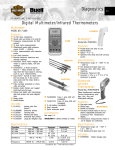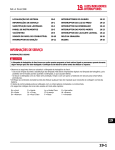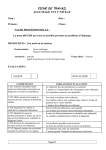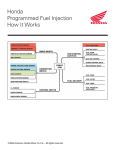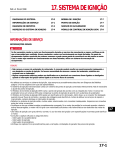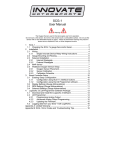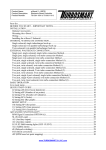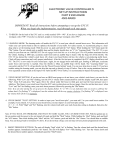Download aquatrax code check - Jet Skis International
Transcript
FUEL SYSTEM (Programmed Fuel Injection) PGM-FI (Programmed Fuel Injection) SYSTEM SELF-DIAGNOSTIC PROCEDURE Fit the safety lanyard clip to the base of the engine stop switch. WARNING LIGHT If the warning light and PGM-FI malfunction indicator lamp (MIL) do not blink, the PGM-FI system has no problem. If the MIL and warning light blink, and the warning buzzer sounds, the PGM-FI system has a problem. MALFUNCTION INDICATOR LAMP (MIL) Push the SET, MODE, ID SET or ID NO. switch for more than 2 seconds to stop the warning buzzer. SET SWITCH MODE SWITCH Push the SET and MODE switches simultaneously for more than 5 seconds to blink the failure code. Read and record how many times the MIL and warning light blinks and determine the cause of the problem (page 8-13). ID SET SWITCH ID NO. SWITCH To read the ECM memory of problem data, perform the following: JUMPER WIRE Pull the safety lanyard clip off of the engine stop switch. Remove the seats (page 3-4). Remove the dummy connector from the service check connector. Connect the service check connector terminals with a jumper wire. SERVICE CHECK CONNECTOR Fit the safety lanyard clip to the base of the engine stop switch. Push the SET and MODE switches simultaneously for more than 5 seconds to blink the failure code. WARNING LIGHT If the ECM has no problem data in its memory, the MIL and warning light will come on and stay on. If the ECM has problem data in its memory, the MIL and warning light will start blinking. Read and record how many times the MIL and warning light blink and determine the cause of the problem (page 8-13). MALFUNCTION INDICATOR LAMP (MIL) 8-9 FUEL SYSTEM (Programmed Fuel Injection) SELF-DIAGNOSTIC MEMORY RESET PROCEDURE 1. Remove the seats (page 3-4). 2. Connect the service check connector terminals using a jumper wire. 3. Fit the safety lanyard clip to the base of the engine stop switch 4. Remove the jumper wire from the service check connector. 5. The MIL and warning light lights about 5 seconds. While the MIL and warning light lights, connect the service check connector terminal again with the jumper wire The self-diagnostic memory is erased, if the MIL and warning light goes off and starts blinking. • The service check connector must be jumped while the MIL and warning light lights. If not, the MIL and warning light will not start blinking. • Note that the self-diagnostic memory cannot be erased if you turn off the engine stop switch before the MIL and warning light starts blinking. JUMPER WIRE SERVICE CHECK CONNECTOR WARNING LIGHT If the MIL and warning light blinks 33 times, the diagnostic memory has not been erased. MALFUNCTION INDICATOR LAMP (MIL) PEAK VOLTAGE INSPECTION PROCEDURE • Use this procedure for the ignition pulse generator and cam pulse generator inspection. • Check cylinder compression and check that all the spark plugs are installed correctly. • Use a commercially available digital multimeter with an impedance of 10 MΩ/DCV minimum. • The display value differs depending upon the internal impedance of the multimeter. Remove the storage box (page 3-8). Disconnect the fuel pump 5P gray connector. 8-10 FUEL PUMP 5P GRAY CONNECTOR FUEL SYSTEM (Programmed Fuel Injection) Connect the peak voltage adaptor to the digital multimeter. TOOLS: IgnitionMate peak voltage tester (U.S.A. only) or Peak voltage adaptor with commercially available digital multimeter (impedance 10 MΩ/DCV minimum) DIGITAL MULTIMETER MTP–08–0193 07HGJ–0020100 (not available in U.S.A.) PEAK VOLTAGE ADAPTOR TEST HARNESS CONNECTION Remove the left side panel (page 3-5). Disconnect the ECM 22P gray and 22P black connectors from the ECM. 22P BLACK CONNECTOR 22P GRAY CONNECTOR ECM Do not disconnect the 6P black connector from the ECM. Connect the test harnesses set to the ECM and ECM connectors. TOOLS: Test harness set 07WMZ-MBGA000 TEST HARNESS SET ECM TEST HARNESS TERMINAL LAYOUT The ECM connector terminals are numbered as shown. B1 B11 C1 C11 B12 B22 C12 C22 Terminals No. 1 to No. 22 of the test pin box of the test harness are for terminals C1 to C22 of the ECM black connector. Terminals No. 31 to No. 52 of the test pin box of the test harness are for terminals B1 to B22 of the ECM gray connector. Example: ECM terminals: B8 (+) – C8 (–) Test pin box terminals: No. 38 – No. 8 GRAY CONNECTOR BLACK CONNECTOR 8-11 FUEL SYSTEM (Programmed Fuel Injection) Terminal conversion chart: 22P black connector terminal No. C1 C2 Test pin box terminal No. 1 2 C21 C22 22P gray connector terminal No. B1 B2 21 22 Test pin box terminal No. 1 2 B21 B22 21 22 TERMINALS FOR 22P BLACK CONNECTOR TERMINALS FOR 22P GRAY CONNECTOR 8-12 FUEL SYSTEM (Programmed Fuel Injection) PGM-FI SELF-DIAGNOSIS MALFUNCTION INDICATOR LAMP (MIL) FAILURE CODES • The PGM-FI malfunction indicator lamp (MIL) denotes the failure codes (the number of blinks from 0 to 47). The MIL has two types of blinks, a long blink and short blink. The long blink lasts for 1.3 seconds, the short blink lasts for 0.5 seconds. When two long blinks occur, and five short blinks, that problem code is 25 (two long blinks = 20 blinks, five short blinks = 5 blinks). Then, go to the flow chart and see problem code 25. • When the Engine Control Module (ECM) stores some failure codes, the MIL shows the failure codes in the order from the lowest number to highest number. For example, when the MIL blinks once, then blinks seven times, two failures have occurred. Follow the flow chart for failure codes 1 and 7. Number of PGM-FI MIL blinks 0 No blinks Causes Symptoms Refer to page • Open circuit at the power input and ground wires of the ECM • Blown sub-fuse D (7.5 A) • Faulty main relay • Open circuit in the main relay related circuits • Faulty engine stop switch • Open circuit in the engine stop switch related circuits • Faulty ECM • Blown main fuse (30 A) • Open circuit in the MIL wire • Faulty ECM • Engine does not start – • Engine operates normally – • Short circuit in the MIL wire • Faulty ECM • Engine operates normally – • Short circuit in the service check connector wire • Engine operates normally – • Loose or poorly connected MAP sensor connector • Open or short circuit in the MAP sensor wire • Faulty MAP sensor • Engine operates normally 8-16 • Loose or poor connection of the MAP sensor vacuum hose • Faulty MAP sensor • Engine operates normally 8-19 • Loose or poorly connected ECT sensor connector • Open or short circuit in the ECT sensor wire • Faulty ECT sensor • Hard to start at low temperatures (ECM controls using preset value; Cooling water temperature: 90°C/194°F) • Engine operates below 3,000 rpm • Poor engine response when operating the throttle quickly (ECM controls using preset value; Throttle opening: 0°) 8-20 No blinks Blinking Stay lit 1 Blink 2 Blinks 7 Blinks 8 • Loose or poorly connected TP sensor connector • Open or short circuit in the TP sensor wire • Faulty TP sensor 8-22 Blinks 8-13 FUEL SYSTEM (Programmed Fuel Injection) Number of PGM-FI MIL blinks 9 Causes Symptoms Refer to page • Engine operates below 3,000 rpm (ECM controls using preset value; Intake air temperature: 25°C/77°F) 8-24 Blinks • Loose or poorly connected IAT sensor connector • Open or short circuit in the IAT sensor wire • Faulty IAT sensor • Engine operates below 3,000 rpm 8-27 Blinks • Loose or poorly connected No. 1 injector connector • Open or short circuit in the No. 1 injector wire • Faulty No. 1 injector • Engine operates below 3,000 rpm 8-29 Blinks • Loose or poorly connected No. 2 injector connector • Open or short circuit in the No. 2 injector wire • Faulty No. 2 injector • Engine operates below 3,000 rpm 8-31 Blinks • Loose or poorly connected No. 3 injector connector • Open or short circuit in the No. 3 injector wire • Faulty No. 3 injector • Engine operates below 3,000 rpm 8-33 Blinks • Loose or poorly connected No. 4 injector connector • Open or short circuit in the No. 4 injector wire • Faulty No. 4 injector • Engine does not start 8-35 Blinks • Loose or poorly connected cam pulse generator connector • Open or short circuit in the cam pulse generator wire • Faulty cam pulse generator • Engine does not start 8-36 Blinks • Loose or poorly connected ignition pulse generator connector • Open or short circuit in the ignition pulse generator wire • Faulty ignition pulse generator • Engine operates below 3,000 rpm 8-38 Blinks • Loose or poorly connected knock sensor connector • Open or short circuit in the knock sensor wire • Faulty knock sensor • Loose or poorly connected IAC valve connector • Open or short circuit in the IAC valve wire • Faulty IAC valve • Engine stalls, hard to start, rough idling 8-39 • Faulty E2-PROM in the ECM • Engine operates normally • Does not hold the self-diagnostic data 8-41 • Loose or poorly connected TCP sensor connector • Open or short circuit in the TCP sensor wire • Faulty TCP sensor • Engine operates below 3,000 rpm 8-42 • Loose or poor connection of the TCP sensor pressure hose • Faulty TCP sensor • Engine operates below 3,000 rpm 8-44 12 13 14 15 18 19 25 29 Blinks 33 Blinks 42 Blinks 43 Blinks 8-14 FUEL SYSTEM (Programmed Fuel Injection) Number of PGM-FI MIL blinks 44 Blinks 45 Blinks 46 Blinks 47 Blinks Refer to page Causes Symptoms • Loose or poorly connected engine oil temperature sensor connector • Open or short circuit in the engine oil temperature sensor wire • Faulty engine oil temperature sensor • Hard to start at low temperatures (ECM controls using preset value; Engine oil temperature: 90°C/194°F) • Engine operates below 3,000 rpm • Engine operates below 3,000 rpm 8-45 • Engine does not start 8-49 • Engine operates below 3,000 rpm when the coolant temperature is 85 – 95°C (185 – 203°F) • Engine does not start when the coolant temperature is above 95°C (203°F) 8-50 • Loose or poorly connected wastegate control solenoid valve connector • Open or short circuit in the wastegate control solenoid valve wire • Faulty wastegate control solenoid valve • Loose or poor connection of the wastegate control solenoid valve hose • Clogged wastegate actuator pressure hose • Faulty wastegate actuator • Faulty TCP sensor • Faulty cooling system • Loose or poorly connected MST switch connector • Open or short circuit in the MST switch wire • Faulty MST switch • Faulty cooling system • Loose or poorly connected ECT sensor connector • Open or short circuit in the ECT sensor wire • Faulty ECT sensor 8-46 8-15







